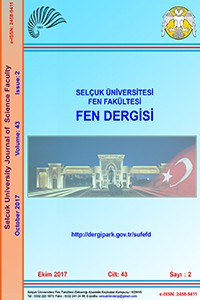Abstract
Ionizing radiation is defined as the radiation
providing the enough energy to free electrons from an atom. The main ionizing
radiations consists of rays containing gamma rays, x-rays, alpha, beta,
neutron, and higher ultraviolet part of the electromegnetic spectrum. However,
the lower ultraviolet part of the electromagnetic spectrum, visible region
rays, and all visible laser rays, infrared, microwaves and radio waves are
known as non-ionizing radiation. Ionizing radiation region is not clearly
defined. Because the ionization energies of atoms and molecules are different.
Accordingly, 10 eV is considered as an apparent upper limit to be non-ionizing
energy. For example, the non-ionizing radiation energy threshold value for the
water molecule is taken as 33 eV. Knowledge of these types of radiation is
important for the information about the negative effects on living beings, and
for the determination of possible environmental precautions. Since ionizing
radiation is not in the visible region, it can not be detected by human senses,
so radiation detection instruments are needed. In this study, the basic
properties of ionizing radiation, the effects on the environment and the
measures to be taken in terms of environmental safety have been examined.
References
- UNSCEAR (2000). (United Nations Scientific Committee on the Effect of AtomicRadiation). Sources, Effects and Risk of Ionizing Radiation. United Nations, New York.
- UNSCEAR (2008). (United Nations Scientific Committee on the Effect of AtomicRadiation). Sources and Effects of Ionizing Radiation. United Nations, New York.
- https://www.iaea.org/about/overview/history/ (Erişim Tarihi: 24. 01. 2017)
- http://www.icrp.org/index.asp/ (Erişim Tarihi: 24. 01. 2017)
- http://www.unscear.org/unscear/en/about_us.html/ (Erişim Tarihi: 24. 01. 2017)
- https://www.epa.gov/history/ (Erişim Tarihi:24.01.2017)
- http://www.taek.gov.tr/kurumsal/taek-in-vizyonu.html/ (Erişim Tarihi: 24. 01. 2017)
- USNRC (United States Nuclear Regulatory Commission), Report No. 93, Ionizing Radiation Exposure of the Population of the United States, 1987.
- Sowby FD(1965). The Recommendations of ICRP. ICRP Publications 9, Pergamon Press 1966, pp. 1399.
- Demir M (2000). Nükleer Tıp Fiziği, İstanbul Üniversitesi Yayınları, İstanbul.
- ICRP (1977). Recommendations of the ICRP. ICRP Publication 26. Ann. ICRP 1 (3).
- ICRP (2012). Compendium of Dose Coefficients based on ICRP Publication 60.
- MEGEP MEB (2011). Radyoloji, Radyasyondan Korunma, 725TTT057. Ankara
- Ege Üniversitesi Tıp Fakültesi Hastanesi (2014).Radyasyon Güvenliği El Kitabı. s.20
- https://www.epa.gov/radiation/protecting-yourself-radiatio (Erişim tarihi: 24. 01. 2017)
Abstract
İyonlaştırıcı radyasyon, bir
atomun yörüngesinden elektron kopararak atomun yüklü veya iyonize olmasına
neden olacak düzeyde yeterli enerji taşıyan radyasyon olarak tanımlanır.
Başlıca iyonlaştırıcı radyasyonlar, gama ışınları, X-ışınları, alfa, beta, nötron
ve elektromanyetik spektrumun yüksek enerji ultraviyole kısmını içeren
ışınlardan oluşur. Bununla birlikte, elektromanyetik spektrumun düşük enerji
ultraviyole kısmı, görünür bölge ışınları ve görünür laser ışınlarının tamamı,
kızılötesi, mikrodalgalar ve radyo dalgaları iyonlaştırıcı olmayan radyasyon
olarak bilinir. İyonlaştırıcı radyasyon bölgesi net bir şekilde
tanımlanmamıştır. Çünkü atomların ve moleküllerin iyonlaşma enerjileri farklı
farklıdır. Buna göre 10 eV değeri iyonlaştırıcı olmayan radyasyon enerjisi için
anlaşılmış bir üst sınır değerdir. Örneğin, su molekülü için iyonlaştırıcı
olmayan radyasyon enerji eşik değeri 33 eV olarak göz önüne alınır. Bu tür
radyasyonlar hakkındaki bilgiler, canlılara olan negatif etkilerin ve çevresel
tedbirlerin belirlenmesinde önemlidir.
İyonlaştırıcı radyasyon görünür bölgede olmadığı için insan duyuları ile
detekte edilemez bu yüzden radyasyon sayaçlarına ihtiyaç duyulur. Bu çalışmada,
iyonlaştırıcı radyasyonun temel özellikleri ile çevreye etkileri ve çevre
güvenliği açısından alınacak tedbirler incelenmiştir.
References
- UNSCEAR (2000). (United Nations Scientific Committee on the Effect of AtomicRadiation). Sources, Effects and Risk of Ionizing Radiation. United Nations, New York.
- UNSCEAR (2008). (United Nations Scientific Committee on the Effect of AtomicRadiation). Sources and Effects of Ionizing Radiation. United Nations, New York.
- https://www.iaea.org/about/overview/history/ (Erişim Tarihi: 24. 01. 2017)
- http://www.icrp.org/index.asp/ (Erişim Tarihi: 24. 01. 2017)
- http://www.unscear.org/unscear/en/about_us.html/ (Erişim Tarihi: 24. 01. 2017)
- https://www.epa.gov/history/ (Erişim Tarihi:24.01.2017)
- http://www.taek.gov.tr/kurumsal/taek-in-vizyonu.html/ (Erişim Tarihi: 24. 01. 2017)
- USNRC (United States Nuclear Regulatory Commission), Report No. 93, Ionizing Radiation Exposure of the Population of the United States, 1987.
- Sowby FD(1965). The Recommendations of ICRP. ICRP Publications 9, Pergamon Press 1966, pp. 1399.
- Demir M (2000). Nükleer Tıp Fiziği, İstanbul Üniversitesi Yayınları, İstanbul.
- ICRP (1977). Recommendations of the ICRP. ICRP Publication 26. Ann. ICRP 1 (3).
- ICRP (2012). Compendium of Dose Coefficients based on ICRP Publication 60.
- MEGEP MEB (2011). Radyoloji, Radyasyondan Korunma, 725TTT057. Ankara
- Ege Üniversitesi Tıp Fakültesi Hastanesi (2014).Radyasyon Güvenliği El Kitabı. s.20
- https://www.epa.gov/radiation/protecting-yourself-radiatio (Erişim tarihi: 24. 01. 2017)
Details
| Subjects | Structural Biology, Environmental Sciences |
|---|---|
| Journal Section | Research Articles |
| Authors | |
| Publication Date | October 31, 2017 |
| Submission Date | February 23, 2017 |
| Published in Issue | Year 2017 Volume: 43 Issue: 2 |
Cite
Journal Owner: On behalf of Selçuk University Faculty of Science, Rector Prof. Dr. Hüseyin YILMAZ
Selcuk University Journal of Science Faculty accepts articles in Turkish and English with original results in basic sciences and other applied sciences. The journal may also include compilations containing current innovations.
It was first published in 1981 as "S.Ü. Fen-Edebiyat Fakültesi Dergisi" and was published under this name until 1984 (Number 1-4).
In 1984, its name was changed to "S.Ü. Fen-Edeb. Fak. Fen Dergisi" and it was published under this name as of the 5th issue.
When the Faculty of Letters and Sciences was separated into the Faculty of Science and the Faculty of Letters with the decision of the Council of Ministers numbered 2008/4344 published in the Official Gazette dated 3 December 2008 and numbered 27073, it has been published as "Selcuk University Journal of Science Faculty" since 2009.
It has been scanned in DergiPark since 2016.

Selcuk University Journal of Science Faculty is licensed under a Creative Commons Attribution-NonCommercial 4.0 International (CC BY-NC 4.0) License.


